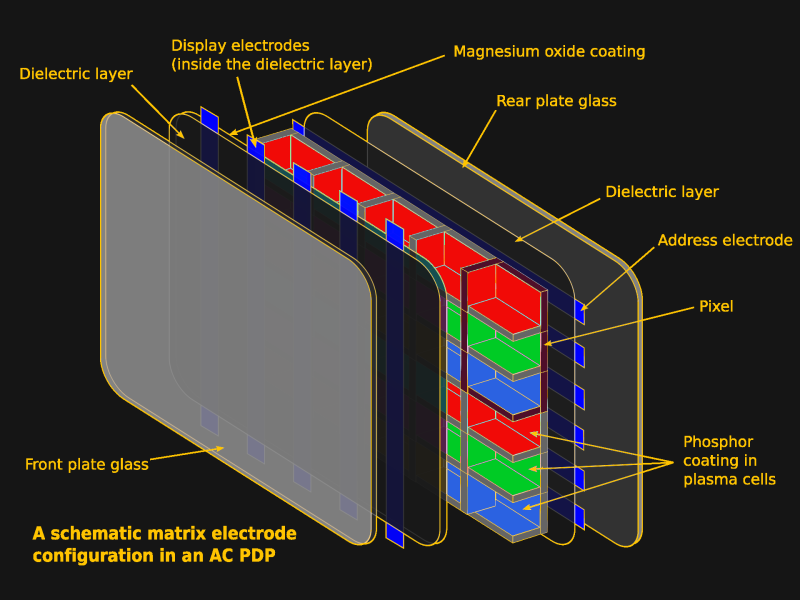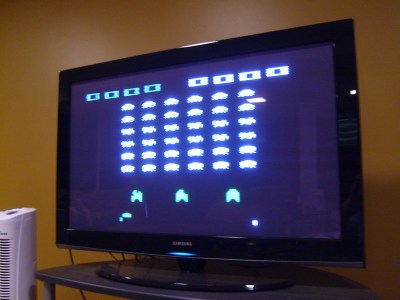I’m sitting in front of an old Sayno Plasma TV as I write this on my media PC. It’s not a productivity machine, by any means, but the screen has the resolution to do it so I started this document to prove a point. That point? Plasma TVs are awesome.
Always the Bridesmaid, Never the Bride

It’s funny, because I firmly believe that without plasma displays, CRTs would have never gone away. Perhaps for that I should hate them, but it’s for the very reasons that Plasma won out over HD-CRTs in the market place that I love them.
What You Get When You Get a Plasma TV
I didn’t used to love Plasma TVs. Until a few years ago, I thought of them like you probably do: clunky, heavy, power-hungry, first-gen flatscreens that were properly consigned to the dustbin of history. Then I bought a house.
The house came with a free TV– a big plasma display in the basement. It was left there for two reasons: it was worthless on the open market and it weighed a tonne. I could take it off the wall by myself, but I could feel the ghost of OSHA past frowning at me when I did. Hauling it up the stairs? Yeah, I’d need a buddy for that… and it was 2020. By the time I was organizing the basement, we’d just gone into lockdown, and buddies were hard to come by. So I put it back on the wall, plugged in my laptop, and turned it on.
I was gobsmacked. It looked exactly like a CRT– a giant, totally flat CRT in glorious 1080p. When I stepped to the side, it struck me again: like a CRT, the viewing angle is “yes”.
How it Works
None of this should have come as a surprise, because I know how a Plasma TV works. I’d just forgotten how good they are. See, a Plasma TV really was an attempt to get all that CRT goodness in a flat screen, and the engineers at Fujitsu, and later elsewhere, really pulled it off.
Like CRTs, you’ve got phosphors excited to produce points of light to create an image– and only when excited, so the blacks are as black as they get. The phosphors are chemically different from those in CRTs but they come in similar colours, so colours on old games and cartoons look right in a way they don’t even on my MacBook’s retina display.
Unlike a CRT, there’s no electron beam scanning the screen, and no shadow mask. Instead, the screen is subdivided into individual pixels inside the flat vacuum panel. The pixels are individually addressed and zapped on and off by an electric current. Unlike a CRT or SED, the voltage here isn’t high enough to generate an electron beam to excite the phosphors; instead the gas discharge inside the display emits enough UV light to do the same job.

Image based on “Plasma-Display-Composition.svg” by [Jari Laamanen].
It’s Not the Same, Though
It’s not a CRT, of course. The biggest difference is that it’s a fixed-pixel display, with all that comes with that. This particular TV has all the ports on the back to make it great for retrogaming, but the NES, or what have you, signal still has to be digitally upscaled to match the resolution. Pixel art goes unblurred by scanlines unless I add it in via emulation, so despite the colour and contrast, it’s not quite the authentic experience.

Those big CRTs don’t have to worry about burn in, either, something I have been very careful in the five years I’ve owned this second-hand plasma display to avoid. I can’t remember thinking much about burn-in with CRTs since we retired the amber-phosphor monitor plugged into the Hercules Graphics card on our family’s 286 PC.
The dreaded specter of burn-in is plasma’s Achilles heel – more than the weight and thickness, which were getting much better before LG pulled the plug as the last company to exit this space, or the Energy Star ratings, which weren’t going to catch up to LED-backlit LCDs, but had improved as well. The fear of burn-in made you skip the plasma, especially for console gaming.

By the end, the phosphors improved and various tricks like jiggling the image pixel-by-pixel were found to avoid burn-in, and it seems to have worked: there’s absolutely no ghosting on my model, and you can sometimes find late-model Plasma TVs for the low, low cost of “get this thing off my wall and up the stairs” that are equally un-haunted. I may grab another, even if I have to pay for it. It’s a lot easier to hide a spare flatscreen than an extra CRT, another advantage to the plasma TVs, and in no case do phosphors last forever.
But Where’s the Hack?
Is “grab an old flat screen instead of hunting around for an impossible CRT” a hack? Maybe it’s not, but it’s worth considering, though, because Plasma TVs don’t get the love they deserve. (And seriously, you’re not going to find the mythical 43-inch CRT, even if it technically existed. And you’ll never find a tube that could match the 152” monster Panasonic put out to claim the record back in the day.)
In the mean time, I’m going to enjoy the contrast ratio, refresh rate, and the bonus space heater. I’m in Canada, and winter is coming, so it’s hard to get too overworked about waste heat when there’s frost on your windowpanes.
Featured image: “IFA 2010 Internationale Funkausstellung Berlin 124” by [Bin im Garten].
















We gave our 60” Panasonic Plasma TV away to the nail technician. She loves it. It was too heavy to mount on the wall when the den was remodeled. But sure do love the 65” OLED we replaced it with!
I’ll probably love OLED too, once people start giving those away in favour of the next new thing. ;)
I only ever looked at a few plasma TV’s when they first came out. The window screen effect was awful. Once I saw it, it was impossible to unsee it. I never looked at a plasma screen as a serious contender after that. They were expensive and ugly. Sounds like they fixed it, or maybe I just ruined them for you too since you’ll now look for it, and won’t be able to unsee it. If they fixed it, this is why first impressions are important. It would have been better to have never released the window screen version.
It’s all about pixel pitch, I think. If that early plasma you saw was built with 480p natural resolution, then it’s going to have bigger squares than the later ones. As the pixels shrink, the width of the “window screen” spacing between the subpixles pretty much needed to get proportionally smaller. With my HD unit, I don’t see it.
Or maybe it’s just that I grew up with parents always yelling at me to sit well back from the particle accelerator pointed at my face and I’m sat far enough back the window screen effect doesn’t resolve in my vision.
That said, the nature of the technology is that you need a physical barrier betwixt subpixels, so yeah, the window screen effect is going to be there if you look at it up close. It’s there with LCDs, too, if you have the Eyes of Horus or a macro lens.
Fun thing: if your “macro lens” is good enough you can even see the glass microspheres that act as the precision spacers in the liquid crystal material between the two glass/electrode/filter sheets.
I always wondered if it was my cursed excellent eyesight that caused me to see it from a distance. Same reason I use 4K monitors unscaled, and read it from 4′ away.
I have no idea what resolution I was looking it. It was “early”. I was young enough to not have “a lot” of tech experience, old enough to have a job and consider saving for good stuff. At the time I determined the only pro was space savings, andthe cons were the window screen effect and price. Price I could have overcome, the space wasn’t a concern for me, but why spend more for a space saving but worse product? So the plasma’s were always a non consideration for me. Now I kind of wish I looked at some of the last generation ones to see what I would have thought.
Not quite true.
A plasma display has to “pre-charge” each pixel to keep the ionized path open, which means there’s some leakage going on and the pixels glow very faintly.
It could turn off, but then the response time would be too slow for moving images. Earlier plasma discharge monitors worked in this way, and they actually operated kinda like neon bulbs where striking the arc would keep it going until the current was cut off, so the display kept a “memory” of the picture until it was erased and re-drawn. Plasma TVs strike every pixel on when first powered up, and then modulate the current that is let through by PWM between the minimum and maximum value to change the brightness.
Plasma TVs are also notorious radio noise generators: That great big glorious window to plasma is also a great big glorious window for millions of electrical arcs and long wire electrode antennas radiating broadband hash.
Anybody in your neighbourhood trying to hear shortwave radio will hear your noise instead. It’s also not hard to find you. You look to a radio sniffer like a grow operation running kilowatts of lights.
But don’t get me started on residential powerline networking — it’s even worse at producing interference, and much more prevalent.
Aye, Especially the early models were absolutely horrendeous noise makers. Considering some of them pulled close to a kilowatt while running does give some hints to the noise levels generated.
I thought long and hard when a local company was selling a massive 103″ Panasonic plasma tv a couple years back for pocket change. Essentially just get it out of our store. (TH-103PF10UK)
This thing was incredible; modular inputs on the back, late model top of the line product.
But it was absolutely absurdly excessive in almost every way.
Massive: I had no way to fit it in my condo, and I’m not sure I could even get it into my condo at the time.
I also did not have enough space to sit far enough back from it, with the calculators saying ~14 foot.
Heavy: it was 500LBS without any stand, and it did not come with a stand.
It came with eye bolts that screw into the top, to hang it from the roof! No VESA mounting for this thing.
Power: It drew 1550W and only from a 240v outlet… so factor in the cost for an electrician as well.
I still don’t have the space to actually own something like this even now that I am in a house, but it rattles around and comes up every year or so…
They also buzz at high altitude. A friend in CO took me to a TV store, quite the din from them.